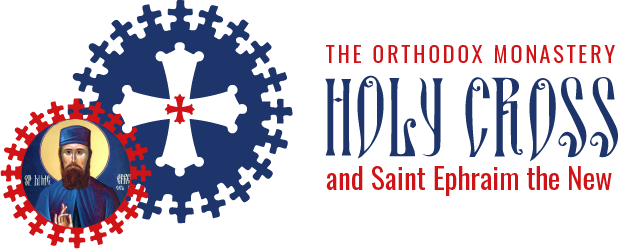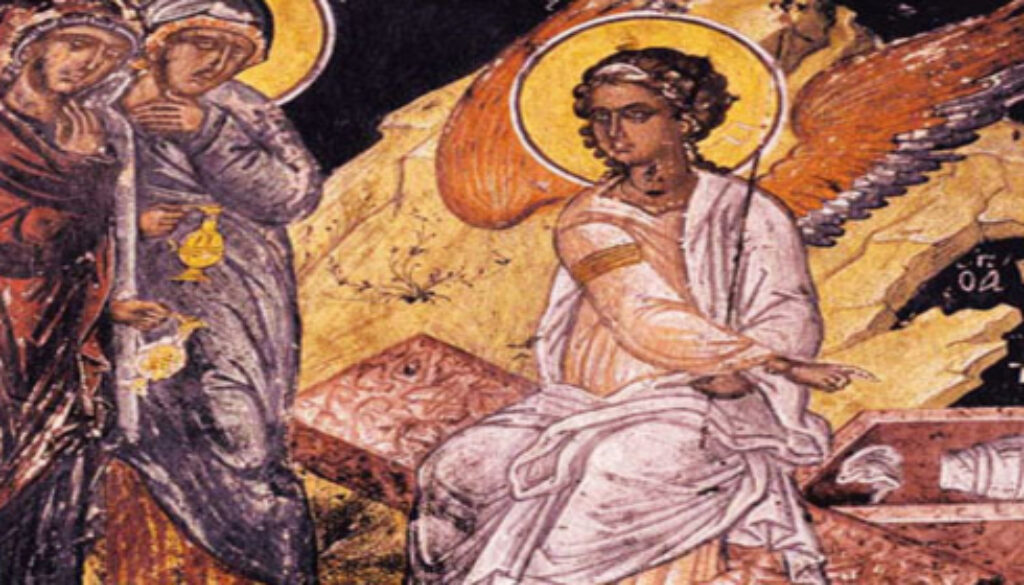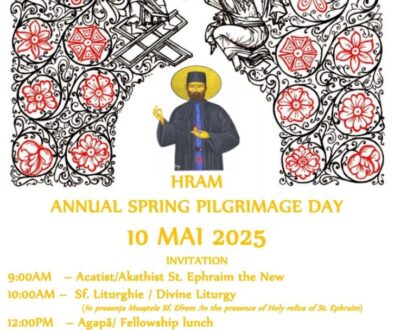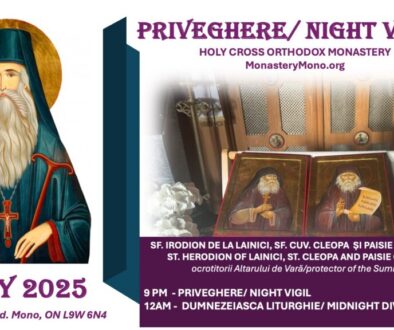† IOAN CASIAN: PASTORAL LETTER AT THE FEAST OF THE LORD’S RESURRECTION, 2021
† IOAN CASIAN: PASTORAL LETTER AT THE FEAST OF THE LORD’S RESURRECTION, 2021
- Category: Headlines
PASTORAL LETTER
AT THE FEAST OF THE LORD’S RESURRECTION, 2021
† IOAN CASIAN
By the mercy of God
Bishop of the Romanian Orthodox Diocese of Canada,
to our Beloved clergy and Orthodox Christians,
peace and joy from Christ, the Risen Lord,
and from us, hierarchical blessing!
“O Christ, great and most holy Pascha!
O Wisdom, Word, and Power of God!
Grant that we may more perfectly partake of Thee
in the never-ending day of Your Kingdom!“
(Canon of Resurrection, Ode 9)
Most Reverend Fathers,
Beloved faithful,
Christ is risen!
The joy of the Resurrection of our Lord Jesus Christ overwhelms us today. It surprises us, as the hymn says, by the fact that although Christ rises from the dead, bringing with Him a fundamental ontological renewal of our human nature, He does so with a complete ‘spiritual elegance of the Spirit’ in His willingness to preserve the purity and undefilement of His steps in creation, in order to restore it. God descends and intervenes in His creation, revealing to us not only the beauty or His distinct sensibility, but also a profound truth — that of man’s redemption and renewal — which cannot be understood without the work of the Holy Spirit, who knows all of God’s mysteries and brings them to the light of our conscience and understanding.
What does the death and resurrection of Christ mean to us?
“In fact, from the beginning, through the man who sinned, we received the evil inheritance from our sinful father, but we also received another inheritance of the One who assumed ours (Christ) and promised us His inheritance—says St. Augustine. We were mortals because of sin, but He assumed death being sinless; He who did not have to die was killed and erased the inscription of sins. Therefore, let your soul be fully assured that we will be resurrected!”[1]
St. Augustine tells us that the death and resurrection of Christ means our redemption from sin and the acquisition of our immortality. Man falls into sin through the temptation of the devil, disobeys the commandment to abstain and fast, which God has given him in paradise. The sin of the first man introduces a state of permanent damage into all human race from which they are unable to escape by their own power.
God, in His boundless love, without being indebted with anything, offers Himself entirely through His Son who becomes the bearer of our human nature through incarnation, a legacy marked by the consequences of sin. Christ, though not responsible for this condition, assumes it out of love for His creation. As God, He accepts crucifixion, assumes a condition which is neither His own nor necessary, the condition of sin and passion, imbedded in the nature of man, whose final outcome was death. This was not the condition that God had imagined for His creation. God descends upon His creature. The descent and assumption of our inheritance marked by sin, is achieved by God in Christ, His Son, in order to fulfill His promise—to restore man to his natural heavenly condition, the condition of deification.
Through Incarnation, Christ, who is the immortality and eternal life, assumes the human nature to overcome death that had infiltrated into the nature of man. At the same time, through this descent He forgives the sin that was inherited through the human nature. The state of disobedience, of drifting away from the word of God, and of revolt against His commandment by the deception of the evil one, became man’s second nature which he alone could not cure.
In what sense can we speak of death as consequence of sin and as punishment, but also as a benefit?
“Having become partakers of evil through our free will — says St. Gregory of Nyssa—we have introduced evil into our nature, because of a temporal pleasure — like a poison mixed with honey — and thus we have fallen away from the happiness due to those free of passions and have turned to wickedness. Because of this, man decomposes, like an earthly vessel which returns again to the earth, so that the evil in man may be cleansed and he may find the original image through the resurrection.”[2]
Man, created in the image and likeness of God in the state of happiness and harmony, which reflected God’s direct creative work, falls into sin through his free will by disobeying the commandment of God on which his life depended. So, the consequence of disobedience was the death of man who was created for eternal life.
St. Gregory of Nyssa understands death also as a blessing, inasmuch as it provides an end to evil so that it does not become eternal. Through sin of disobedience, death penetrates the body of man and puts an end to the nature marked by sin in the grave by its returning to the earth from which it was taken. Death thus becomes the premise of man’s resurrection with a renewed body as God had created it in the beginning. Through the resurrection man finds the original image of God in which he was created.
How was our union with God achieved for renewal and eternal life?
“There was nothing in Himself to die for us if he had not taken a mortal body from us—says St. Augustine. This way, the Immortal was able to die, this way He wanted to give life to the mortals, then making partakers of Him the ones with whom He had been a part of before. Therefore, He made a wonderful exchange with us through mutual participation: our part was the one that died; His part will be the one from which we shall live.”[3]
The fulfillment of the plan for man’s redemption, restoration, and renewal was done on God’s initiative because of His unconditional love. It was a wonderful but asymmetrical exchange: the non-debtor with death—that is, Christ God—pays with His death the debt owed by the indebted—that is, man, and the one who owed death—that is, man—receives immortality and forgiveness of sins through the death of the One who had no debt—that is, Christ God. We see here the infinite love of God, who is not bound in any way by sin, redeems man’s debt with death, and heals the wound of death imbedded in his nature.
How does the Church anticipate this mystery of Christ’s death and resurrection and its consequences?
The Church lives the mystery of Christ’s death and resurrection and its consequences in at least two ways: the first is participation in the Holy Eucharist by partaking the medicine or nourishment of eternity that is the Body and Blood of the dead and resurrected Christ; the second is the anticipated experience of Christ’s death and resurrection through the cleansing of sins, the killing of passions and the acquisition of virtues, which is called a first resurrection, a guarantee, or pre-tasting of the final universal resurrection.
“(…) The Resurrection of Christ has a deep connection with history – says Father Dumitru Stăniloae – and it must show history its importance, or its beginning as a force for pneumatization, to channel history towards the superhistorical plan opened by it. Better said, towards the plan of spirituality which transcends it.”[4]
The Resurrection of Christ has an immediate impact with the greatest efficiency on history, being a pneumatic causality [5] upon it. To the extent that man by faith opens himself to this new pneumatic experience, it makes itself present in his life through the grace of the Divine Liturgy, the Sacraments, and the work of virtues. As members of the Church, we live this experience of Christ’s resurrection and its consequences every moment we are present in Church. This is why we can say that in the Church we live in full communion with the entire creation, seen and unseen, of all times and all places because all are present before God and by our openness to the superhistorical plan of the kingdom of God through the Resurrection we ensure our full communion with all in God.
Beloved brothers and sisters in the Lord,
This is the Homage Year to the Pastoral care of Romanians abroad and the Commemorative Year of the fallen asleep in the Lord; the liturgical and cultural value of cemeteries. It is a year in which we think more about our role as Christians here and now. We are trying to be in closer communion with the people back home. It is a time when we must think about the values that have constituted the foundation for our identity as Romanian Orthodox Christians, and for our existence and permanence in history. Church, family and school are the three values or elements on which our Christian consciousness and our formation for life were based. The Church has given us the sense of permanence, dignity and ethics, as well as the spiritual elevation; the family has given us the possibility of communion and a sense of belonging to a common origin; the school has prepared us for life, making us citizens of this world.
The Romanian Patriarchate chose three protectors for this special year – St. John Cassian, St. John of Neamt and St. Dionysius Exiguus.
St. John Cassian (360-433), who is also one of the protectors of our Diocese, grew up in the spirit of Dobrogean monasticism, attended the school of the great Egyptian monasticism, becoming an important spiritual author and intellectual reference for Christian life in the West.
St. John of Neamt (1913-1960), a descendant of the Neamt monasticism, rigorous and ascetic, endeavored and achieved sainthood by living in the Holy Land, putting in verse and prose his experiences, thoughts and reflections that form a healthy spiritual foundation for a modern world in continuous quest and renewal.
St. Dionysius Exiguus (470-544), visibly marked our world by establishing the calendar of our era, counting the years since the birth of Christ.
Following the example of the three Romanian saints, let us also become steadfast confessors of the Orthodox faith, outstanding representatives of our traditional Christian values proven by time and experience, and let us learn from every good thing something useful to us and others!
2021 is a year dedicated to the fallen asleep and to the cemeteries and their value. The Church reminds us, through the teaching of faith about life thereafter and of the fallen asleep, that man’s life here on earth is only a part of his entire life. In the Church, in the Divine Liturgy and in the Holy Mysteries, we live mysteriously this communion with those passed on to the Lord. There is a dynamic of our prayer for the souls of the fallen asleep and a request of our saints to intercede with God for us. We are in a prayerful communion with the fallen asleep – saints or simple people – praying for each other.
For us Christians, cemeteries are visible confessions of our faith in eternal life. The crosses, the candles, the way in which the fallen sleep are positioned in the grave, speak of their faith and of ours. They speak about hope and the eternal value of our life. They constitute a testimony and strengthen our faith in the resurrection. St. Augustine says, “In fact, this kind of care given to the dead body, which will rise and remain for eternity is in a way a confession of faith in the resurrection.”[6]
Cemeteries also remind us, by the popular or traditional themes specific to each nation, of their particular and specific identity, as well as of the fact that each one is part of a common origin. They remind us that we owe our life to God in the first place but also to those before us. The generations that are resting in cemeteries give us a sense of humility, for we understand that we are one of the countless souls given by God, but also of the solidarity between us as part of the same humanity blessed and redeemed by Him.
Coming to Church we find ourselves in coexistence: living and departed. We mention them in our prayers, and they intercede for us. Therefore, we make up a single family of faithful around God. Christian cemeteries remind us that we don’t remain prisoners of time and the limited space of earthly life but expect another life of fulness in communion and perfect love.
St. John Chrysostom exhorts us: “This is the pinnacle of the Christian faith—to wait for the true life after death, to hope that we will return after we have departed.”[7]
Beloved faithful,
For over a year, we have been going through a period of many uncertainties and difficulties and many obstacles against a normal functioning as a Church. The hardest exercise of this period was the lack of concrete communion, which is the DNA of our ecclesial life. We now come to a better realization that the communion between us, the human and spiritual relations, the common prayer are important and are part of a healthy way of being a Christian in society, both from a physical and spiritual point of view. Even if each priest tried to fulfill the spiritual needs of his parishioners virtually or otherwise, we realize that the means are few, limited and insufficient. Let us find shelter with the Healer of our souls and bodies – Christ – who through incarnation, death, and resurrection redeemed and transfigured our nature, giving it the possibility for eternity.
On the occasion of the Feast of the Lord’s Resurrection, let us rejoice and glorify Christ the risen Lord on the third day from the tomb, asking Him to protect us – clergy and faithful – and to grant comfort to the suffering, health to the sick, strength in faith to the doubtful, joy in communion with our neighbor, and love for one another.
At the beginning of this Pascal season, I wish you all holy joy and blessing from God in Jesus Christ our Lord!
CHRIST IS RISEN!
Yours in prayer to Christ the Lord, desirous of every blessing,
† IOAN CASIAN
Saint-Hubert/Montreal 2021
______________
[1]About the Resurrection of Bodies in St. John Chrysostom, St. Augustine, Pseudo-Cyprian. Writings about death and resurrection (translation, introduction, notes by Corneliu Clop/vol. 1). Ed. EIBMO: Bucharest 2018, p 61
[2] About the soul and resurrection (translation, notes and comments by Fr. Grigore Teodorescu). Ed. Herald: Bucharest 2003, p 128
[3]About the Lord’s passions in Writings … p 49
[4] Orthodox Dogmatic Theology (vol. 2). Ed. EIBMBOR: Bucharest 2003, p 170
[5] Ibidem
[6]About the proper care we should have for the dead in Writings… p 228
[7]About comfort in the face of death in Writings… p 154




